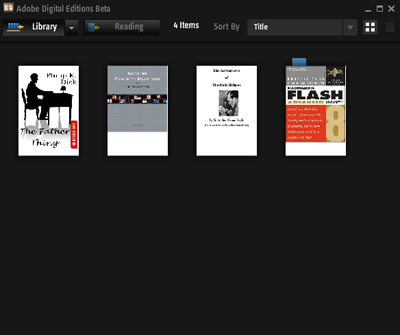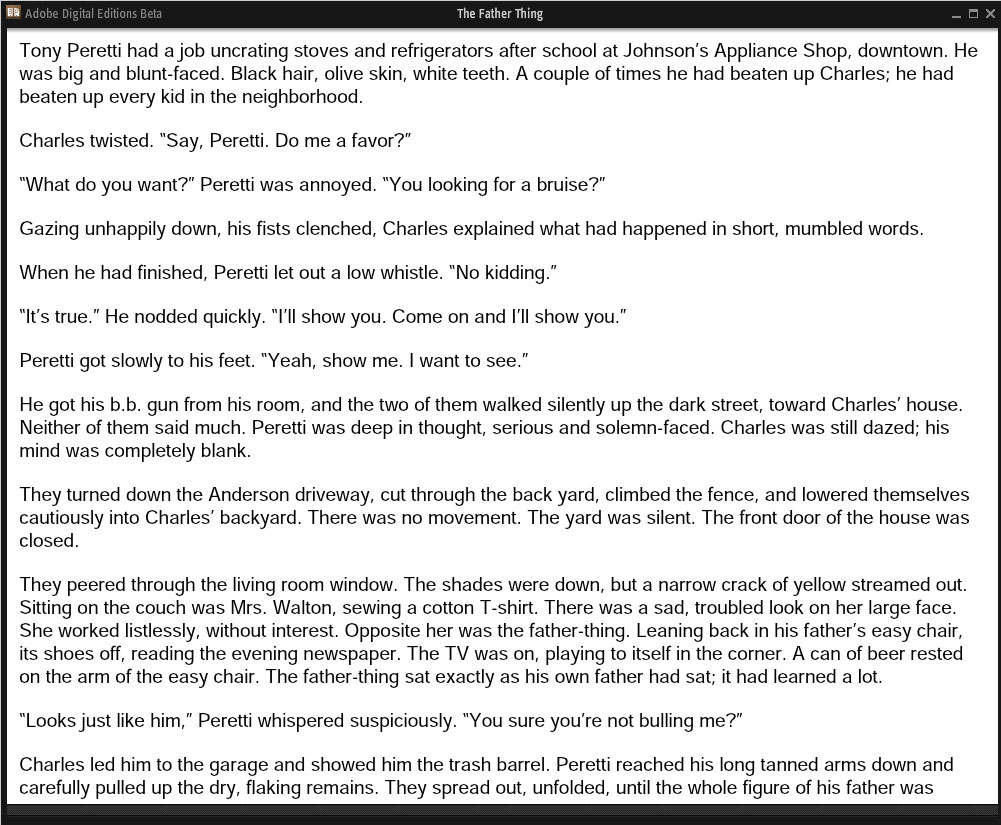Adobe have just dropped the first fruit of their takeover of Macromedia – and it’s book-related. New eReader technology Adobe Digital Editions is a Flash-based Rich Internet Application – that is, it takes all of the online benefits of connectivity and streams them through a pleasant, pervasive interface that lets you interact with things rather than just look at them. Supposedly.
The most impressive thing about it is undoubtedly how easy it is to install and play with. Go have a try over at Adobe Labs. There are plenty of free sample books available there too.
Once launched, it becomes less easy to see why Adobe think DE will “energize the eBook and digital publishing market” – the first impression is of a kind of iTunes bookshelf:

Books download very quickly, and appear as thumbnails in your library. It all looks very nice. However, there doesn’t seem to be very much beyond this: essentially, these are just PDFs, a format that, while pretty, is actually extremely strict and quite limiting. As a result, the reading display, which appears when a book is selected, is nothing to shout about (click for full-size version):
It’s nice and clear – big, obviously – but it’s still got that classic PDF problem: no scrolling. Pages jump from one to the next – like a paper book, admittedly, but counterinuitive and confusing on a screen – and there’s little whitespace, which is how paper books draw the eye to the text and away from the distractions of the margin. And we’re not even going to start on the fact that it appears to be set entirely in sans-serif fonts.
So what’s the difference between this and a regular PDF, apart from a slick, web-based interface (very now)? Not much, that I can see – it’s essentially Acrobat on Flash. Except that the PDFs now come wrapped in another proprietary format, ETD, with all kinds of extra DRM opportunities built in for the publishers.
Proprietary formats are not the future of eBooks, not only because consumers hate intrusive DRM as much as publishers love it, and have consistently shown this by migrating to apps with weaker DRM wherever possible, but because they will want to read their eBooks on a multiplicity of devices, not all necessarily from the same company, and will choose the format which allows them to do this.
This new app offers absolutely no advances on other eReaders – in fact, it’s a step back. Please try harder, Adobe.
Sources: Adobe Press Release, The Book Standard, ZDNet.

This is not correct. Aside PDF, Digital Editions supports a new e-document format called Open eBook which aims at becoming the e-document standard, and it’s based on open specifications. Open eBook is neither proprietary nor has it anything to do with PDF. The wrapper format is called OCF and is also based on open standards (it’s basically a ZIP container). It is not used for PDF files.
You can find more about those proposed standards here:
http://www.idpf.org/specs.htm
And my initial review of Adobe DE here:
http://www.mobileread.com/forums/showthread.php?threadid=8221
Comment by Alex — October 25, 2006 @ 2:28 pm
I take your point, and should have made it clearer that the reader does accept other formats than PDFs – The Sherlock Holmes example I downloaded is XHTML, and not, I think, markedly different from the OEBF, which is XML-based.
However, DE treats such files as PDFs – it still separates them into discrete pages, doesn’t allow scrolling, loses your place when you resize the window and, worst of all, when you turn a page, it brings down a menu bar which obscures the first line of the new page!
My point is, Adobe hasn’t created anything new here – it’s just a new look for a very old style, and one that deserves to be superceded.
Comment by James Bridle — October 25, 2006 @ 2:52 pm
well, adobe digital editions 1.0 was released yesterday. seems, they tried harder…
Comment by Klaudia — June 21, 2007 @ 7:27 am